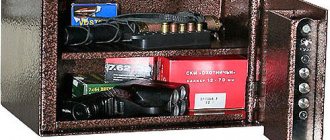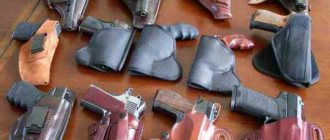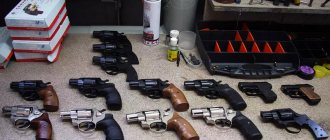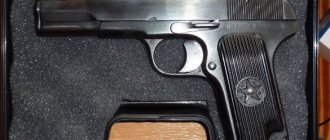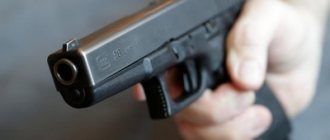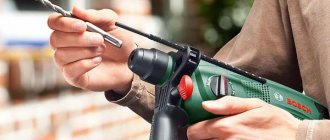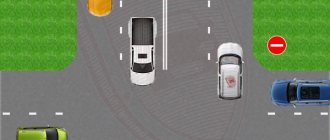In recent years, traumatic weapons have often become a necessity for modern people. Proper use of it guarantees safety in situations that threaten health and life. The wearing and use of trauma equipment in Russia is regulated by Federal Law and regulations. You need to know them so as not to become a lawbreaker.
- What is a traumatic weapon from the point of view of the law?
- Who can use traumatic weapons
- Requirements for wearing and using trauma equipment
- In what cases can traumatic weapons be used?
- Shots and distances
- What to do after using a weapon
- Consequences of illegal use of traumatic drugs
- Rules for storing weapons
What is a traumatic weapon from the point of view of the law?
By law, traumatic firearms are called limited-destruction firearms (LDL), which fire rubber (traumatic) bullets. It is used to temporarily injure the attacker (in order to prevent illegal actions against oneself and one’s property).
In Russia, only OOOP (domestic production) is used as a traumatic weapon, and much less often smooth-bore firearms with traumatic cartridges.
According to the law, you must first obtain a special permit (before purchasing an LLC) to use, carry and properly store it. The legislation stipulates special technical characteristics of traumatic weapons, such as:
- use only for self-defense;
- the use of rubber (traumatic) ammunition - other types of ammunition are prohibited;
- the muzzle energy rate is limited - no more than 91 J;
- The magazine has a capacity of 6-10 cartridges.
In order for it to be legal to carry and use for necessary defense purposes, a license must be obtained.
Obtaining a license. Algorithm
When you have definitely decided on the need for a traumatic weapon for yourself, then before purchasing it you will need to perform the following procedure:
- Learn the correct use of weapons. It is also important to know how it should be stored and in what cases to use it.
- Obtain permission to purchase.
- Pass a medical examination. Here, certificates from specialists such as a narcologist and a psychiatrist are of greatest importance. Their conclusions are valid for one year. And the commission itself should be completed annually, when you already become the owner of a weapon.
- Obtaining a license to use, maintain and carry an injury.
- Buying reliable storage for weapons.
Who can use traumatic weapons
The following persons are allowed to carry and use personal protective equipment:
- military personnel;
- special official groups of citizens;
- civilians for self-defense;
- athletes for sport shooting;
- citizens whose profession requires protection from attacks by predators (hunters or protection of livestock);
- persons in need of protection, according to state law.
Persons under 21 years of age will be denied a special permit to use LLCP according to the law of the Russian Federation.
The procedure for obtaining permission to carry and store weapons is as follows:
- Passing (for money) a medical examination. Visiting a therapist, psychiatrist, ophthalmologist, narcologist (in public medical institutions). Obtaining a certificate in format 046-1.
- Studying courses (up to 15 hours) on handling, using traumatism, mastering practice and passing an exam (paid).
- Applying to the LRO police department, attaching an application, a medical certificate in the required format (see paragraph 1 above), a document confirming completion of a training course in handling OOP, a copy of the passport, a 3x4 photo (2 pcs.), a paid receipt for the state duty and a certificate of no criminal record .
The license will be ready in 10-15 days, and its validity is 5 years.
Requirements for wearing and using trauma equipment
Any owner of a trauma vehicle must comply with the rules for using this LLC. Lack of permits to use weapons is punishable by law:
- failure to comply with the rules for carrying and storing OOOP - a fine of up to 2,000 rubles, the violator’s pistol and ammunition will be confiscated until the causes of the violation are eliminated;
- for an illegally purchased pistol, as well as carrying and storing it (without formalized documents) - punishment is a fine of 3,000-5,000 rubles; in this situation, cartridges and weapons are confiscated free of charge.
In the latter case, even the arrest of the offender is allowed.
The owner of an LLC should be aware that the law prohibits:
- install additional elements on the gun - for example, a muffler;
- use of weapons by persons under the influence of drugs and alcohol;
- have more than 2 traumatic PEOPs with you;
- carry the weapon cocked (not with the safety catch on), there should be no cartridges in the chamber;
- appear in public places while suffering from trauma - in the theater, cinema, parks, cafes, canteens, medical institutions, kindergartens or schools (with the exception of security guards).
A citizen must always carry a traumatic weapon in a holster. The owner of the gun must have personal documents (passport, driver's license, hunting license) and a pistol license with him.
When the permit to carry a weapon expires, the owner must come to the police station three months before the actual expiration of the permit to renew it for another five years. The documentation provided is the same as when registering for the first time, except for the training program courses. An expired permit will result in a warning or a fine of RUB 3,000.
Chaotic and thoughtless reactions by the owner of a weapon, including excesses of self-defense, are not acceptable. If a dangerous situation arises, where there is a clear threat to life, health and property damage, a citizen must act in a clear sequence:
- It is necessary to warn the attacking offender. To do this, you should take the pistol out of the holster, jerk the bolt, fire an upward shot (warning), or cock the hammer (warning that a shot will be fired in the direction of the attacker). Warnings are appropriate: “Stop! I’m shooting!”
- Only after the first warning stage do they move on to the second - they fire a shot at the attacking person or animal (predator). At the second stage of the shot, it should be remembered that the shot must be fired from a remote distance.
- Dangerous moments arise when there is simply no time for the first stage - warning, and you need to quickly defend yourself. In this situation, it is permissible to fire shots at the attacker. Next, the owner of the weapon must write an explanatory note for the police.
And in order not to suddenly turn from a defender into an attacker, it is advisable to invite a lawyer.
In what cases can traumatic weapons be used?
Traumatic weapons should be used only in moments when there is a real threat to health, life or damage to things or property. The owner of the LLC's task is to stop the attack, but not to eliminate the offender.
You should not cross this fine line, which could be regarded as exceeding acceptable self-defense. We should not forget that in recent years there have been many cameras both on the streets and in public places, on vehicles - DVRs, and every passer-by has a smartphone with a camera. This fact can be both positive and negative when considering the current situation.
For example, if a driver sitting in a car is attacked by an offender, breaking a car window and threatening his life, then the use of OOOP by the car owner would be appropriate. But in practice, it happens that after shooting at the attacker, the defender cannot “stop”, and in a rage continues to shoot in the back of the already fleeing offender. And this is already exceeding the limits of necessary self-defense.
Actions for self-defense
This is the most interesting and subtle moment. And the line between protecting yourself and crime is very thin.
The use of traumatic weapons for self-defense is provided for by law. And if you are attacked, first fire a warning shot in the air. You can make verbal threats or simply show off a gun. If the aggressor calms down and abandons his intentions, the weapon may not be used. But it is activated if the warning measures have no effect on it.
In some situations, you do not have the opportunity to warn about the use of an injury:
- The aggressor is already exerting physical influence.
- He has a weapon pointed at you.
These are extremely difficult cases, often resulting in death. They can be prevented if we manage to avoid armed conflict.
Shots and distances
Since a traumatic weapon does not have the goal of defeating the attacker (to the point of death) and causing serious harm to health, one should shoot from a remote distance (so that the harm to health is minimal).
You should be aware that from a distance of 3-6 m, bullets penetrate 1-1.5 cm into muscle tissue, which is relatively harmless to health. If the distance between the weapon owner and the attacker is less than 3 meters, then internal organ injuries are already possible. Therefore, shooting at close range is extremely dangerous - it is possible to exceed self-defense. Especially if the bullets hit the head or face - you can easily kill with a trauma weapon. You will have to answer to the law “to the fullest.”
Where you can't shoot
According to the law of the Russian Federation, when using a traumatic pistol for self-defense, you should know that it is prohibited to aim and shoot at the neck and head, the back of the head, as well as the groin area and areas where vital organs are located. It is recommended to shoot at the arms, legs and chest.
What to do after using a weapon
In the case of using a traumatic weapon for its intended purpose, firing shots at an offender, you must follow the instructions. According to the law of the Russian Federation, after firing a pistol at an offender, a citizen is obliged to:
- notify the police about your protective actions, notification must be no later than within 24 hours;
- after this, it is worth photographing the scene of the incident and the location of the cartridges (they should not be touched);
- you need to find witnesses to the situation you saw;
- When the police arrive, the gun owner must testify and bring witnesses.
Only after this can you leave the scene of the incident.
Ask a Question
Question to the expert
Is it possible to leave the scene of the incident after shooting at an attacker with a traumatic weapon?
No. You should immediately report the incident to the police.
If in self-defense, at the moment of shooting, the attacker was seriously injured from my weapon, can I simply walk away (with a sense of accomplishment)?
No. It is necessary to promptly call an ambulance. This will avoid Art. 114 of the Criminal Code (Exceeding the limits of necessary self-defense).
If a wounded offender's phone rings, what should you do?
It is worth notifying the attacker’s relatives and loved ones about what happened so that they are aware (by phone). It is also necessary to inform your loved ones about the current dangerous situation.
Consequences of illegal use of traumatic drugs
The law clearly states that traumatic weapons must be used strictly for their intended purpose - for self-defense and the protection of one’s property.
If trauma is used not for self-defense, but, on the contrary, for an attack or other illegal actions, then the owner of the weapon faces liability:
- Administrative - possible in the case when the owner uses a weapon, for example, to shoot birds on the streets of the city (without causing damage to other people's property or injuring people). The punishment in this case will be under Art. 20.13 of the Code of the Russian Federation on Administrative Offences. It provides for a fine of up to 1,000 rubles. and confiscation of the pistol along with ammunition. You should know that you can develop shooting practice only in specially designated places - shooting ranges.
- Civil – used for the illegal use of weapons, after which material and moral harm is caused to citizens. According to Art. 1064 of the Civil Code of the Russian Federation, the owner of the weapon will fully compensate for the damage and harm caused. The amount of compensation is determined by the court in the process of assessing and taking into account all the circumstances.
- Criminal - possible in case of weighty and serious facts, when a person is killed, or harm to health is committed - moderate or severe. Criminal liability also applies to hooliganism. According to the Criminal Code of the Russian Federation, punishment for these offenses (determined by the court) can be in the form of fines, imprisonment or forced labor.
Therefore, according to the law, the owner of an LLC must use trauma equipment only in a dangerous situation, and do not forget about the great responsibility.
About the need for a license
The main tasks here are:
- Accounting for all gun owners.
- Checking the health of all applicants for a license and their ability to use a trauma device.
- Limit its massive illegal exploitation.
- Compliance with the rules for the use of traumatic weapons.
The last point is the most important. After all, it already applies to owners of such pistols who have mandatory licenses.
Rules for storing weapons
After purchasing an LLC, the owner is obliged to maintain the weapon in accordance with the existing rules for storing firearms and pneumatic weapons (according to the laws of the Russian Federation). Provisions have been established for the safe storage at home of not only weapons, but also ammunition, to isolate them from the gaze of strangers and access (especially children!).
Storage is permitted to legal entities and individuals; each of these categories must obtain a permit (medical certificate) after passing a medical examination. After this, a legal or natural person in an organization, enterprise, factory, or in his home:
- installs special metal weapon cabinets;
- they are usually attached to the floor or wall with reliable fasteners;
- combat charges should be stored in a specialized separate sector of the safe, which is additionally locked (for security);
- Cabinet locks require increased reliability and burglary resistance.
The cabinet must have a safe for storing cartridges. In the absence of the latter, the law prohibits the possession of weapons at home. The owner must always keep the keys to a gun safe or cabinet.
Weapons that can be purchased without registration with the Department of Internal Affairs and licenses may be stored without a permit. These include:
- Signal pistols.
- Weapons with minimal muzzle energy (up to 3 J), pneumatic revolvers.
- Products that resemble a weapon in design (a lighter in the shape of a pistol, etc.).
- Revolvers with a small caliber - up to 6 mm, and ammunition for them.
Currently, you can easily purchase the required safe or cabinet for storing weapons in specialized stores. You should choose stores with a good reputation in order to purchase quality goods from manufacturers, and not fakes (made of thin metal with bad locks). Cabinets and safes for storing weapons must be made of metal with a thickness of more than 2 mm. (high strength).
After purchasing a weapon (within six months from the date of issue of the license), the owner is required to obtain a permit to carry and store weapons. To do this you should:
- come to the police station with a statement;
- provide a copy of the license to purchase weapons, with stamps and signatures, dates of the store (purchase) and a receipt;
- show a paid receipt of the state fee (for registration);
- prepare 3x4 photographs in the amount of 2 pieces;
- show the insurance that is taken out when buying a weapon.
Since it is necessary to make test shots at the LRO within two weeks from the purchased pistol, shell casings from the shooting are also enclosed with the statement to the police.
Then, within ten days, the district police officer must check the owner’s compliance with the conditions for storing weapons (at the applicant’s residential address). The permit will be refused if the conditions are not met, for example, a cabinet is missing. Violations will include:
- storing traumatic items outside the safe;
- expired license;
- keeping a weapon loaded;
- an unlocked or broken safe;
- obvious or easy access to the safe by unauthorized persons or family members.
For violation of the necessary storage conditions of an LLC, the owner faces a fine of up to 2,000 rubles. or deprivation of license for up to 2 years. Also, failure to comply with the rules for storing weapons can lead to the death of a person. In this case, the owner of the LLC faces punishment up to imprisonment.
Criminal measures
They usually involve the payment of fines by the violator. In some cases, he becomes the object of administrative arrest.
For violation of the rules for carrying and using traumatic weapons, according to Art. 20.8, fines are imposed in the range of 500 - 2000 rubles. Similar punishment is applied for an out-of-date license and improper disposal of the weapon itself and its ammunition.
If an individual purchases a pistol without a license, then she can be fined 3,000-5,000 rubles. The following measures may also be applied:
- Confiscate the pistol and ammunition free of charge.
- Deprive the right to subsequent storage and use of traumatic weapons. The period of such restriction varies from 6 months to 2 years.
If this offense is committed by an official, for example an employee of a private security company, then it can be:
- Oblige to pay a fine from 5,000 to 15,000 rubles.
- Release from this position and impose temporary restrictions on such work. Their range: 1-3 years.
If the violator is a legal entity, then fines are applied in the range from 100,000 to 500,000 rubles.
They may also be prohibited from engaging in professional activities for a maximum of 2 months.
There is no provision for any arrest.
They come into play when a person is in possession of an unregistered weapon (and other weapons).
According to the law of the Russian Federation, the use of traumatic weapons that do not have identification entails punishment:
- Fine up to 80,000 rubles.
- Forced community service.
- Arrest up to 6 months.
- Imprisonment for a maximum of 4 years.
So says the article. 222 of the Criminal Code. Also, according to it, a citizen’s freedom may be limited for a period of up to 3 years.
If a person stores this weapon carelessly, then he is liable under Art. 224 CC. Various penalties may be applied to him.
